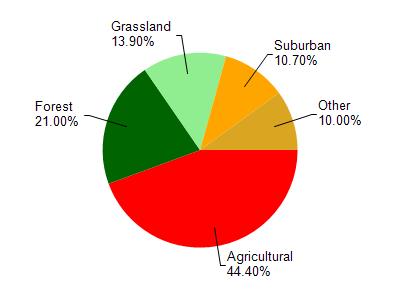Chippewa
No
No
No
Fish and Aquatic Life
Overview
These Duncan Creek impoundments are generally shallow, eutrophic, and support a warm water
fishery. The impoundments have very high nutrient levels that result in nuisance growth of
duckweed and excessive sedimentation that is filling in the impoundments. The impoundments are
included in the Duncan Creek Priority Watershed Program, whch will control sources of polluted
runoff. Reductions in sediment delivery will lengthen the useful life of the impoundments. It is
unlikely that nutrient inputs can be reduced enough through the priority watershed project to
result in decreased growth of duckweed (Schreiber 1992).
The submergent aquatic plants of these impoundments are limited to species adapted to low light,
eutrophic conditions and high siltation rates. These lakes also contain large mats of duckweed
covering more than half the surface area at times. Physical removal of duckweed and harvesting of
other aquatic plants are management options for control of nuisance levels of rooted aquatic plants
(Borman) .
Date 1996
Author Aquatic Biologist
Historical Description
Source: 1963, Surface Water Resources of Chippewa County Glen Lock Flowage T29N, R8W, Sections 30 and 31
It is a soft water, drainage impoundment on Duncan Creek at Chippewa Falls. It has a 21 -foot headwater control structure on its outlet operated by the Chippewa Falls Pure Ice Co. It is managed for largemouth bass and pan fish. Muskrats are common as well as a few nesting mallards. A golf course and ten cottages occupy the east side of the lake. The west side lake shore of 1.23 miles is in city ownership as part of Irvine Park. An access road with limited parking is located near the outlet.
Surface Acres = 44.5, S.D.F. = 3.30, Maximum Depth = 20 feet
Date 1963
Author Surface Water Inventory Of Wisconsin
Condition
Wisconsin has over 84,000 miles of streams, 15,000 lakes and milllions of acres of wetlands. Assessing the condition of this vast amount of water is challenging. The state's water monitoring program uses a media-based, cross-program approach to analyze water condition. An updated monitoring strategy (2015-2020) is now available. Compliance with Clean Water Act fishable, swimmable standards are located in the Executive Summary of Water Condition in 2018. See also the 'monitoring and projects' tab.
Reports
Management Goals
Wisconsin's Water Quality Standards provide qualitative and quantitative goals for waters that are protective of Fishable, Swimmable conditions [Learn more]. Waters that do not meet water quality standards are considered impaired and restoration actions are planned and carried out until the water is once again fishable and swimmable
Management goals can include creation or implementation of a Total Maximum Daily Load analysis, a Nine Key Element Plan, or other restoration work, education and outreach and more. If specific recommendations exist for this water, they will be displayed below online.
Monitoring
Monitoring the condition of a river, stream, or lake includes gathering physical, chemical, biological, and habitat data. Comprehensive studies often gather all these parameters in great detail, while lighter assessment events will involve sampling physical, chemical and biological data such as macroinvertebrates. Aquatic macroinvertebrates and fish communities integrate watershed or catchment condition, providing great insight into overall ecosystem health. Chemical and habitat parameters tell researchers more about human induced problems including contaminated runoff, point source dischargers, or habitat issues that foster or limit the potential of aquatic communities to thrive in a given area. Wisconsin's Water Monitoring Strategy was recenty updated.
Grants and Management Projects
| Project Name (Click for Details) | Year Started |
|---|
|
|
Monitoring Projects
| WBIC | Official Waterbody Name | Station ID | Station Name | Earliest Fieldwork Date | Latest Fieldwork Date | View Station | View Data |
|---|
| 2151000 | Glen Loch Flowage | 10001049 | Glen Loch Lake | 8/29/2000 | 10/3/2016 | Map | Data |
| 2151000 | Glen Loch Flowage | 093114 | Glen Loch Lake - Deepest Point | 3/14/1991 | 8/27/1992 | Map | Data |
|

Watershed Characteristics
Glen Loch Flowage is located in the Duncan Creek watershed which is 191.44 mi². Land use in the watershed is primarily agricultural (44.40%), forest (21%) and a mix of grassland (13.90%) and other uses (20.70%). This watershed has 270.37 stream miles, 185.45 lake acres and 6,971.50 wetland acres.
Nonpoint Source Characteristics
This watershed is ranked Not Available for runoff impacts on streams, Not Available for runoff impacts on lakes and High for runoff impacts on groundwater and therefore has an overall rank of High. This value can be used in ranking the watershed or individual waterbodies for grant funding under state and county programs.However, all waters are affected by diffuse pollutant sources regardless of initial water quality. Applications for specific runoff projects under state or county grant programs may be pursued. For more information, go to surface water program grants.